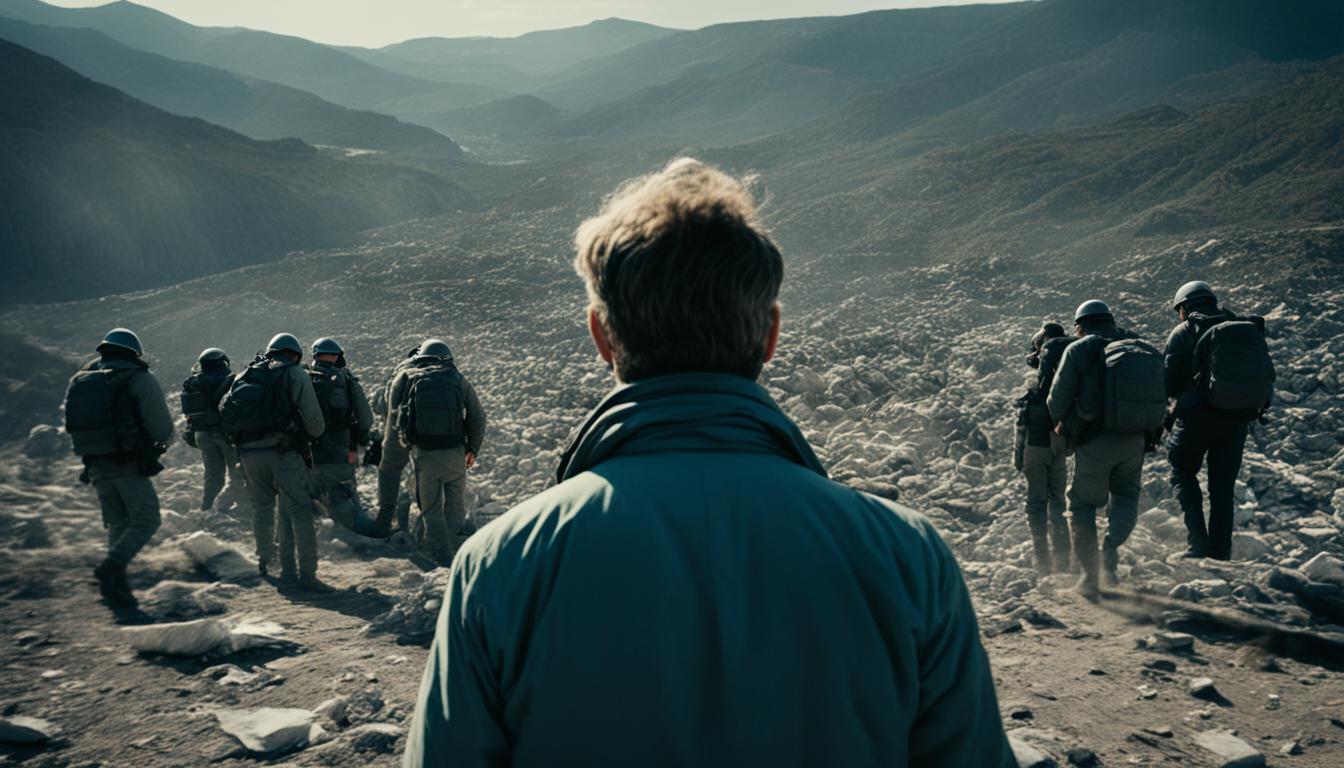When engaging in documentary photography projects, it is crucial for us to prioritize ethical considerations. As photographers, we have the power to shed light on social and cultural issues, but it is equally important to ensure that our work does not harm or misrepresent the subjects involved.
In this article, we will explore the various ethical considerations that photographers should keep in mind when undertaking documentary projects. By understanding and implementing ethical practices, we can create impactful visual stories that contribute to a better understanding of social issues and promote positive change.
Before we dive into the specific aspects of ethical documentary photography, let’s remember the power and responsibility we hold as storytellers to depict reality honestly and respectfully.
Key Takeaways:
- Documentary photographers have the responsibility to prioritize ethical considerations in their work.
- By obtaining informed consent, photographers can maintain transparency and respect for the autonomy of the individuals they photograph.
- The advancement of technology requires photographers to carefully consider potential risks and breaches of privacy.
- Photographic manipulation raises ethical concerns and should be approached with transparency and clear communication.
- Balancing the need to capture compelling stories with respect for privacy is essential in documentary photography.
The Role of Informed Consent in Documentary Photography
Informed consent is a vital aspect of ethical documentary photography. As photographers, we have a responsibility to inform our subjects about the purpose and potential impact of our images. This includes obtaining explicit consent for their use in our projects. By doing so, we demonstrate respect for the individuals we photograph and uphold their autonomy.
Obtaining informed consent entails more than a simple release form. It involves engaging in open and honest conversations with our subjects, ensuring they understand how their images will be used and how they may impact their lives and communities. These conversations can be challenging but are necessary to establish trust and mutual understanding.
We must be transparent about our intentions and the potential consequences our photographs may have. This involves disclosing the context and purpose of our projects, as well as any potential risks or benefits that may arise from participating. It is essential to answer any questions our subjects may have and address their concerns with empathy and sensitivity.
Informed consent is not just a legal obligation; it is an ethical imperative. It is a way for us, as photographers, to acknowledge the agency and dignity of the individuals we document. By obtaining consent, we ensure that their voices are heard and their stories are told with integrity.
By adhering to strict informed consent practices, we create an environment of respect and trust. This empowers our subjects to share their experiences more freely, knowing that their rights and privacy are protected. It also allows us to deliver authentic and meaningful narratives that accurately represent the diverse perspectives within our communities.
The Benefits of Informed Consent
Informed consent benefits both photographers and subjects. For photographers, it mitigates the risk of legal and ethical challenges regarding the use of the images. It also helps establish a sustainable relationship with our subjects, fostering long-term collaboration and ongoing trust.
For subjects, informed consent provides them with a sense of control over how their images are used and disseminated. It allows them to actively participate in the storytelling process and advocate for themselves and their communities. By involving subjects in decision-making, we ensure their stories are told on their own terms.
The Power of Collaboration
Informed consent is more than a legal formality; it is a collaborative process. By involving our subjects in decision-making, we acknowledge their expertise and lived experiences. We become partners in telling their stories, working together to create narratives that are respectful, inclusive, and true to their realities.
This collaborative approach also helps us navigate complex ethical considerations, such as issues of representation, exploitation, and potential harm. By actively involving our subjects in the process, we can better understand their perspectives and ensure our work reflects their experiences accurately.
The Impact of Technology on the Ethics of Documentary Photography
As technology continues to advance, it has brought significant changes to the field of documentary photography. With features like embedded location data and facial recognition, photographers now have powerful tools at their disposal. However, these technological advancements also raise ethical concerns that should not be overlooked.
Photographers must carefully consider the potential risks and breaches of privacy that come with the use of such tools. The embedded location data, for instance, may inadvertently reveal sensitive information about the subjects or the location itself. Facial recognition technology, on the other hand, raises questions about consent and the invasion of privacy.
The Balance Between Technology and Ethics
While technology can enhance the storytelling capabilities of documentary photography, it is crucial for photographers to make informed decisions and maintain ethical standards. This requires them to assess the potential implications of using technology and weigh them against the welfare and rights of the subjects they photograph.
“Technology should be used responsibly and with ethical considerations in mind. It is our responsibility as photographers to ensure that the use of technology does not compromise the dignity and privacy of our subjects.”
By being mindful of the impact of technology on ethical considerations, photographers can navigate these challenges more responsibly and responsibly document the realities they seek to capture.
| Technology | Ethics | Documentary Photography |
|---|---|---|
| Embedded location data | Breaches of privacy | Enhanced storytelling |
| Facial recognition | Consent and invasion of privacy | Ethical decisions and responsibilities |
As technology continues to evolve, documentary photographers must remain cognizant of the ethical implications. By staying informed and following ethical guidelines, photographers can leverage technology responsibly while respecting the rights and autonomy of those in front of their lens.

Explore more in our upcoming sections as we delve further into the various ethical considerations and challenges present in documentary photography.
Photographic Manipulation’s Impact on the Ethics of Documentary Photography
The ease of digital manipulation has raised ethical concerns in documentary photography. Some argue that manipulation is necessary for storytelling purposes, while others believe it undermines the credibility of the images and the photographer’s role as a witness to events.
Photographic manipulation refers to altering or modifying images to enhance or alter their content. It can involve anything from basic color correction to more complex changes like adding or removing elements from the scene. While manipulation can be tempting to create visually striking images, it raises questions about truthfulness and objectivity in documentary photography.
At the heart of documentary photography lies the goal of capturing reality and presenting an unbiased account of events. Manipulating images risks distorting the truth, potentially leading to misrepresentation and deception. Documentary photographers have a responsibility to uphold the principles of honesty and integrity in their work.
“By manipulating photographs, we risk compromising the integrity of our storytelling and betraying the trust of our audience. It is essential that we maintain transparency and communicate honestly about any alterations made to our images.”
Transparency is key in maintaining ethical standards in documentary photography. By clearly communicating any manipulation done to the images, photographers can be transparent with their audience and maintain the trust that is vital to the genre. This can be achieved through captions or accompanying statements where photographers explain the purpose and extent of any modifications made.
Furthermore, establishing ethical guidelines within the documentary photography community can help ensure responsible manipulation practices. These guidelines may include clearly defining acceptable levels of manipulation, encouraging photographers to prioritize accuracy and truthfulness in their work.
Examples:
Several instances of controversial photographic manipulation have challenged the ethics of documentary photography in recent years. One such example is the Steve McCurry “Afghan Girl” photograph. McCurry, known for his poignant and powerful images, faced criticism when it was revealed that he had altered elements of the photograph to enhance its visual impact. This incident sparked a broader conversation about the line between manipulation and authenticity in documentary photography.
In another instance, the Pulitzer Prize-winning photograph by Brian Walski titled “The Cloning of the Firefighters” came under scrutiny when it was discovered that Walski had combined different elements from multiple photographs to create a more compelling composition. This incident highlighted the ethical implications of altering the factual accuracy of an image for dramatic effect.
Privacy Concerns in Documentary Photography
In the world of documentary photography, balancing the need to capture compelling stories with respect for privacy is an ethical challenge we must address. As photographers, we have a responsibility to consider the potential impact of our images on the subjects involved. This includes recognizing and addressing the privacy concerns that may arise when documenting sensitive or intimate situations.
Obtaining explicit permission from our subjects is crucial, especially in situations that may expose personal information or vulnerable moments. By engaging in open communication and respecting boundaries, we can ensure that our practices align with ethical standards when documenting the private lives and stories of individuals.
Privacy concerns often arise when portraying individuals in their most vulnerable states or revealing details that could lead to harm or stigmatization. It is essential for us to approach these situations with sensitivity, compassion, and a deep understanding of the potential consequences.
Documentary photographers must navigate a fine line between capturing authentic moments and preserving the dignity and privacy of the subjects. While our goal is to document and shed light on important social and cultural issues, we must always prioritize the well-being and consent of those we photograph.
Respecting privacy also means being cautious about the technology we use in our practice. As advancements continue to shape the field of photography, we must critically evaluate tools such as facial recognition and embedded location data. It is our responsibility to ensure that these technologies do not invade the privacy of our subjects or contribute to any potential breaches.
“Respecting privacy means being cautious about the technology we use in our practice.”
To emphasize the importance of privacy concerns in documentary photography, let’s take a moment to reflect on the potential impact of our work. We have the power to amplify voices, challenge stereotypes, and advocate for change. However, we must also recognize the potential harm that can be caused when privacy boundaries are crossed.

| Privacy Concerns in Documentary Photography | Ethical Considerations |
|---|---|
| The need to balance storytelling and privacy | Respecting subjects and their boundaries |
| Obtaining explicit consent for intimate or sensitive situations | Prioritizing well-being and consent |
| Being cautious about the use of technology and potential breaches | Ensuring privacy and avoiding harm |
By being mindful of privacy concerns and approaching our work with empathy and integrity, we can create ethical documentary photography that inspires change while respecting the rights and well-being of the subjects we capture.
Conclusion
In the realm of documentary photography, ethical considerations are of paramount importance. By placing emphasis on informed consent, privacy protection, transparency in technology use, and the avoidance of manipulative practices, photographers can craft visual narratives that are both ethical and impactful. Through the power of ethical documentary photography, we can foster a better comprehension of social issues and drive positive change within our world.
By prioritizing informed consent, photographers acknowledge the autonomy and agency of their subjects. Respecting the privacy of those being photographed is another critical aspect of ethical practice, as it ensures that the images produced do not invade or harm the individuals involved.
Transparency in the use of technology is also crucial. Documentary photographers must consider the potential implications of cryptographic metadata and facial recognition technologies, making informed decisions to uphold the privacy and dignity of their subjects.
Furthermore, maintaining credibility and integrity is paramount. By avoiding manipulative practices such as excessive photo manipulation or staging, photographers can ensure that their work remains a genuine portrayal of events and elicits authentic emotional responses from viewers.
Ultimately, by adhering to these ethical considerations, documentary photographers become agents of change, using their visual storytelling skills to shine a light on social issues, raise awareness, and promote positive transformations within our society.
FAQ
What are some ethical considerations in documentary photography?
Some ethical considerations in documentary photography include obtaining informed consent from subjects, respecting privacy, avoiding manipulation of images, and being transparent about the use of technology.
Why is informed consent important in documentary photography?
Informed consent is important in documentary photography to ensure transparency, respect for autonomy, and to inform subjects about the purpose and potential impact of their images.
How does technology impact the ethics of documentary photography?
Technology in documentary photography raises concerns about breaches of privacy, the use of location data, and facial recognition. Photographers must consider the potential risks and implications when using these tools.
What is the impact of photographic manipulation on the ethics of documentary photography?
Photographic manipulation raises concerns about the credibility of images and the role of the photographer as a witness. Transparency and clear communication about manipulation are essential to maintain ethical standards.
What are some privacy concerns in documentary photography?
Privacy concerns in documentary photography include the potential impact of images on subjects, especially in sensitive or intimate situations. Obtaining explicit permission and respecting boundaries are important ethical practices.
How do ethical considerations contribute to visual storytelling in documentary photography?
By prioritizing ethical considerations, photographers can create impactful and authentic visual stories that promote understanding of social issues and contribute to positive change in the world.
What Are Some Ethical Considerations to Keep in Mind when Taking Documentary Photographs?
When taking documentary photographs, it is crucial to adhere to ethical editorial photography standards. This includes obtaining consent from subjects, representing them accurately, and avoiding exploitation or harm. Additionally, photographers should consider the impact of their work on the subjects and the broader community.




